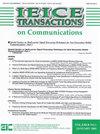格约简辅助MIMO接收机的叠加信号输入解码
IF 0.6
4区 计算机科学
Q3 Engineering
引用次数: 0
摘要
本文提出了一种用于格约简辅助MIMO接收机的低复杂度软输入解码的新方法。该方法将由格约简辅助线性检测器产生的硬判决信号组成的软信号馈送给软输入解码器。软信号是由格约简辅助线性检测器输出的硬决策信号附近的候选向量的加权和。为了获得更高的传输性能,本文提出了一种适应信道的权重调整技术。此外,为了提高传输性能,我们建议引入一个用于权重的系数。在4 × 4 MIMO信道中对传输性能进行了评估。当使用线性MMSE滤波器或串行干扰消除器作为线性检测器时,所提出的技术达到约1。在误码率为10−5时,该解码器的传输性能优于硬判决信号解码器。此外,定量评价了所提出的技术的低计算复杂度。本文章由计算机程序翻译,如有差异,请以英文原文为准。
Superposition Signal Input Decoding for Lattice Reduction-Aided MIMO Receivers
SUMMARY This paper proposes a novel approach to low complexity soft input decoding for lattice reduction-aided MIMO receivers. The proposed approach feeds a soft input decoder with soft signals made from hard decision signals generated by using a lattice reduction-aided linear detector. The soft signal is a weighted-sum of some candidate vectors that are near by the hard decision signal coming out from the lattice reduction-aided linear detector. This paper proposes a technique to adjust the weight adapt to the channel for the higher transmission performance. Furthermore, we propose to introduce a coe ffi cient that is used for the weights in order to enhance the transmission performance. The transmission performance is evaluated in a 4 × 4 MIMO channel. When a linear MMSE filter or a serial interference canceller is used as the linear detector, the proposed technique achieves about 1 . 0dB better transmission performance at the BER of 10 − 5 than the decoder fed with the hard decision signals. In addition, the low computational complexity of the proposed technique is quantitatively evaluated.
求助全文
通过发布文献求助,成功后即可免费获取论文全文。
去求助
来源期刊

IEICE Transactions on Communications
ENGINEERING, ELECTRICAL & ELECTRONIC-TELECOMMUNICATIONS
CiteScore
1.50
自引率
28.60%
发文量
101
期刊介绍:
The IEICE Transactions on Communications is an all-electronic journal published occasionally by the Institute of Electronics, Information and Communication Engineers (IEICE) and edited by the Communications Society in IEICE. The IEICE Transactions on Communications publishes original, peer-reviewed papers that embrace the entire field of communications, including:
- Fundamental Theories for Communications
- Energy in Electronics Communications
- Transmission Systems and Transmission Equipment for Communications
- Optical Fiber for Communications
- Fiber-Optic Transmission for Communications
- Network System
- Network
- Internet
- Network Management/Operation
- Antennas and Propagation
- Electromagnetic Compatibility (EMC)
- Wireless Communication Technologies
- Terrestrial Wireless Communication/Broadcasting Technologies
- Satellite Communications
- Sensing
- Navigation, Guidance and Control Systems
- Space Utilization Systems for Communications
- Multimedia Systems for Communication
 求助内容:
求助内容: 应助结果提醒方式:
应助结果提醒方式:


